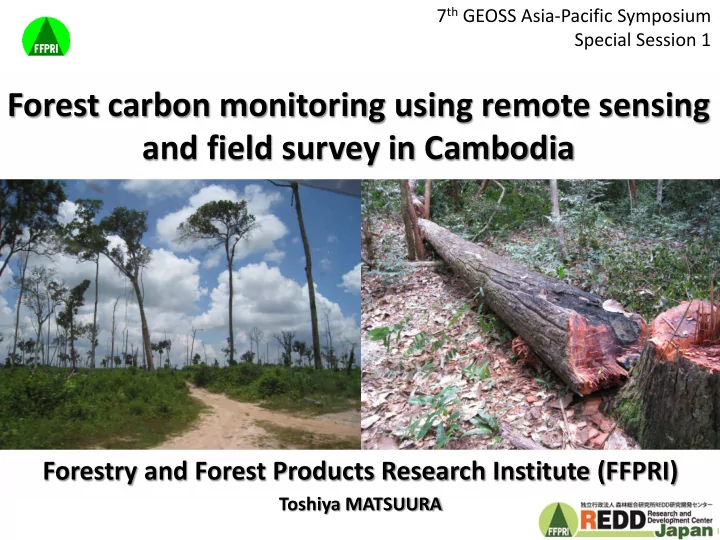

7 th GEOSS Asia-Pacific Symposium Special Session 1 Forest carbon monitoring using remote sensing and field survey in Cambodia Forestry and Forest Products Research Institute (FFPRI) Toshiya MATSUURA 1
In this presentation, Forest carbon monitoring for REDD+ 1. Seasonality adjustment of satellite imagery 2. Recent deforestation trend after 2000s 3. Carbon stock loss by land use change (e.g., rubber plantation) 2
Forest carbon monitoring for REDD+ Remote sensing Field survey Decision of forest classes Evergreen Deciduous Image Plot survey classification Others e.g. Rubber, Mangrove Verification Allometry Forest area i Mean carbon stock i Total carbon stock = Σ ( Forest area i x Mean carbon stock i ) 3
(1) Seasonal change in Cambodia (MODIS-NDVI) November December January February March April October NDVI high low 4 NDVI: normalized difference vegetation index
(1) Seasonality adjustment by spectral normalization Before : SPOT-4 Sharp spectral change. Different range of reflectance. After : Similar range of reflectance within each vegetation class. Inconspicuous boundary between scenes. Reflectance Green band NIR band Red band 5 Langner et al. (2014) Remote Sensing of Environment, 143, 122-130.
(2) Recent deforestation after 2000s 2002-2006 2006-2010 2010-2013 Chinit river basin (3,644km 2 ) Forest Deforested Non-Forest Cloud & shadow mask Economic land concession (ELC) 0 20 40 km 6 (mainly for commercial rubber plantation)
(2) Recent deforestation after 2000s (cont.) In the Chinit river basin (3,644km 2 ) Carbon stock change Deforested area (km 2 ) (Mt-C) About 50000 800km 2 800 outside ELC 40000 About 600 ELC 6 times 30000 sum(F) Forest Doubled 400 20000 200km 2 Rubber plantation (ELC) sum(RP) 10000 200 100km 2 Doubled 0 0 Year 2002 2006 2010 2013 2002-2006 2006-2010 2010-2013 (Cloud-shadow mask were excluded in 2013) 7
Deforestation drivers (A) Rubber plantation in ELC (economic land concession) Year Ye 2010 10 – 2012 2012 2005 05 – 2009 2009 2000 00 – 2004 2004 1996 96 – 1999 1999 Distribution of ELC (Source: Open Dev. Cambodia) (ha) (B) Cassava farming by locals 20,000 Wet rice Upland rice 15,000 Soybean 10,000 Cassava 5,000 0 2005 2007 2009 2011 2013 Eastern Kompong Thom (Cash crop for export, e.g., biofuel, feed, and food) 8 (Kurashima, unpublished)
(3) Carbon balance (Rubber plantation) (Mg/ha) Secondary forest = 270 Mg/ha 300 Tree biomass −65 MgC/ha (AGB+BGB ) 200 Rubber plantation: 140 Mg/ha (Root) Time-averaged biomass 100 y = -0.12 x 2 + 13.29 x - 28.95 (30 years for one rotation) R² = 0.95 0 0 20 40 60 Rubber age (years after logging) (MgC/ha) 60 Soil Organic −28 MgC/ha 40 Carbon (SOC) 20 (< 30 cm depth) 0 -5 0 5 10 15 20 25 30 35 40 45 50 55 60 Rubber age (years after logging) Large carbon loss (approx. 93 MgC/ha ) 9 Litter & dead wood matters are not included.
Summary 1.Seasonality adjustment of satellite imagery deciduous forest 2.Deforestation accelerated by economic development Rubber & cassava 3.Carbon loss by land use change Rubber plantation Thanks for your kind attention! 10
Recommend
More recommend